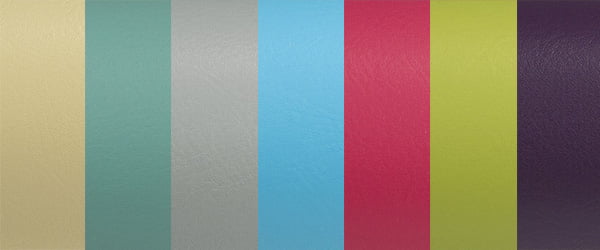
Side by side comparison, a poorly produced vinyl fabric will ‘look’ the same as a highly engineered version.
A known idiom reminds us not to be ‘penny wise, pound foolish’ and in almost any purchase or specification decision we can easily get seduced by a lower price and not fully realise the actual cost. We have all experienced this in one form or another, but is this apparent in a fabric specification decision? Surely fabric is fabric?
Unfortunately, not all fabrics are created equally and vinyl fabric is no exception. As vinyl is a synthetic material, it can be manufactured in many ways. The marketplace has both ‘The Good and the Bad Vinyl Fabrics’. Matkovic ́ et al highlights some of the factors that contribute to good quality vinyl production which include;
- using good quality raw materials,
- ensuring precise control of how PU paste with the paper passes through the dryer at the correct speed of 10 mm/min,
- how the temperature needs to be adjusted to 80℃ to allow drying of various solvents which need to evaporate.
Not correctly managing any of these steps can have dramatic effects on the end product. Unfortunately, to look at the product, even in a side by side comparison, a poorly produced vinyl fabric will ‘look’ the same as a highly engineered version. The difference only becomes apparent after some use.
In ‘Coated Textiles: Principles and Applications’ Sen points out that upholstery fabric is made up of layers fixed to a cotton base fabric;
These fabrics contain a knitted base fabric, a polyurethane foam middle layer and a wear-resistant top coat…The composite is then foamed, cross-linked, and laminated to a textile base…An important requirement of the upholstery fabric is that it should have proper flame-retardant additive to reduce the ignitability of the products.
Additional ingredients can also be added to improve the fabrics performance. For instance UV (ultraviolet) stabilisers can also be added to protect the fabric in direct sunlight. Again, from looking at a highly engineered fabric, compared to a poor grade one, there is no way of knowing if the product has UV stabilisers included and again this will not be known until the fabric starts to fade or flake after exposure to sunlight.
Even the quantity used in each layer has a massive impact on the vinyl and the cost associated with producing it. Coated Textiles: Principles and Applications points out that;
Upholstery-grade cloth has a thick foam layer ranging from 360 to 480 grams per meter squared, a top layer of 180 to 360 grams per meter squared.
Producing vinyl fabric below these tolerances, which is common practice in cheaper grade vinyls, will naturally result in an inferior product, yet may remain unknown to the buyer. Typically, cheaper vinyl manufacturers use less expensive ‘fillers’ and as Sen further points out, ‘the primary role of a filler in PVC is reduction in cost’. Extensive use of filler in the production of a fabric will again have no initial visual indication.
Again, performance would only become apparent when in situ.
One major furniture store in the UK, DFS, came under heavy criticism for supplying poor quality furniture recently. The knock on effect was damage to the DFS brand and an investigation by BBC TV who pointed out that due to the poor quality fabric being used in their leather and faux leather sofas, they failed the necessary standards for UK fire safety regulations and were therefore shown as illegal for sale in the UK. Secondary costs such as the re-upholstery and transport are never factored in along with the damage caused to the brand and negative publicity generated. As a specifier, supplier or manufacturer of furniture, is it worth the risk? If you visit a restaurant, store or office and notice poor quality upholstered furniture where the colour is fading, rubbing off or the material is flaking, what impression does this create? What does this communicate about the organisation or brand?
As highlighted in Mix Magazine March 2015 edition, as dealerships evolve and respond to a marketplace that views furniture as part of brand identity, contract furniture companies, are under constant pressures to deliver quality products with the correct margins. They can easily be seduced by a lower fabric price. However, for their customers, they are the centre of knowledge and excellence and must examine their client’s needs objectively and supply a coherent solution. Thinking ‘fabric is fabric’ can easily lead to poor quality selection with the end result being threefold:
damaging the relationship with the client,
weakening the ‘consultant’ position,
having to absorb the additional cost of having to collect, transport, re-upholstery and re-deliver.
- damaging the relationship with the client,
- weakening the ‘consultant’ position,
- having to absorb the additional cost of having to collect, transport, re-upholstery and re-deliver.
All of which epitomises ‘penny wise, pound foolish’.
References
Matkovic, V, Cubric, I, and Skenderi, Z. (2014) ‘Thermal resistance of polyurethane-coated knitted fabrics before and after weathering’, Textile Research Journal, November 2014 vol. 84 no. 19. pp. 2015-2025.
Sen, A. K (2007) Coated Textiles: Principles and Applications, Second Edition, Florida, USA:CRC Press, pp.148
BBC, (2015). Your Money Their Tricks – DFS sales tactics – BBC One. [online] Available at: http://www.bbc.co.uk/programmes/articles/r5pvRcspQH8jjJ5JJpNkvq/dfs-sales-tactics [Accessed 16 Apr. 2015].
Furniturenews.net, (2015). Furniture retailers implicated in BBC’s fire regulation investigation. [online] Available at: http://www.furniturenews.net/news/articles/2014/01/1675215348-furniture-retailers-implicated-bbcs-fire-regulation-investigation [Accessed 16 Apr. 2015].
Mixinteriors.com, (2015). Spotlight: The Dealer Market | March 2015. [online] Available at: http://www.mixinteriors.com/march-x2015/i/630/desc/spotlight-the-dealer-market/ [Accessed 17 Apr. 2015].
Save
